Autism Case Study: IEP Development and Intervention Plan for Children
VerifiedAdded on 2023/05/28
|15
|3082
|78
Report
AI Summary
This report presents a case study of Desmond, a seven-year-old child with autism, detailing his current level of performance, specific learning and behavioral needs, and possible compounding factors affecting his learning behavior, such as anxiety, sensory issues, physiological factors, comorbidity, and general intellectual difficulties. It includes an Individualized Education Plan (IEP) outlining Desmond's strengths, concerns, and needs, with specific cognitive, language, social, and behavioral goals. The IEP also incorporates occupational therapy strategies and interventions aimed at improving Desmond's overall development and integration in a school environment. This assignment contributed by a student, is available on Desklib, a platform offering a variety of study resources including solved assignments and past papers.
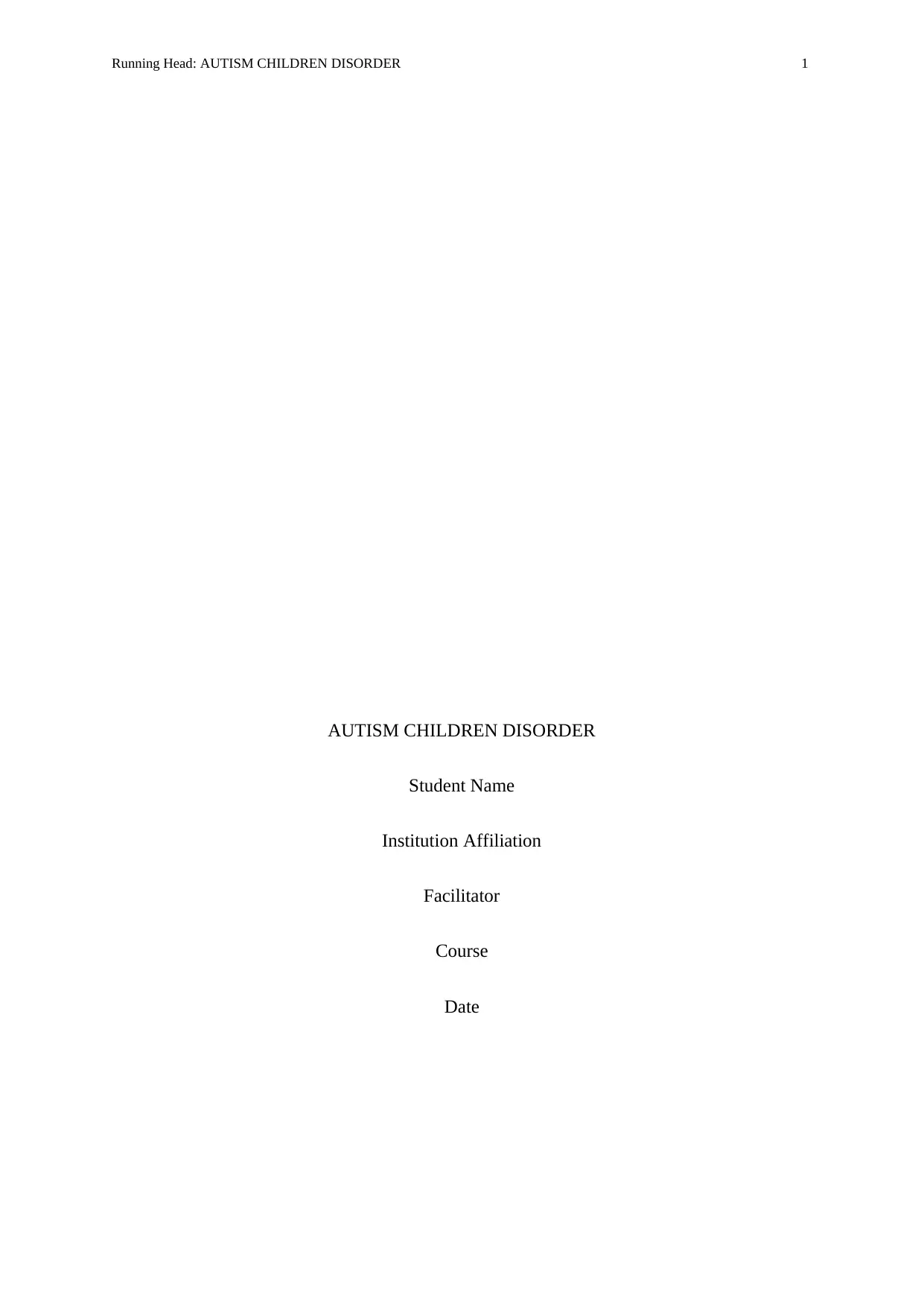
Running Head: AUTISM CHILDREN DISORDER 1
AUTISM CHILDREN DISORDER
Student Name
Institution Affiliation
Facilitator
Course
Date
AUTISM CHILDREN DISORDER
Student Name
Institution Affiliation
Facilitator
Course
Date
Paraphrase This Document
Need a fresh take? Get an instant paraphrase of this document with our AI Paraphraser
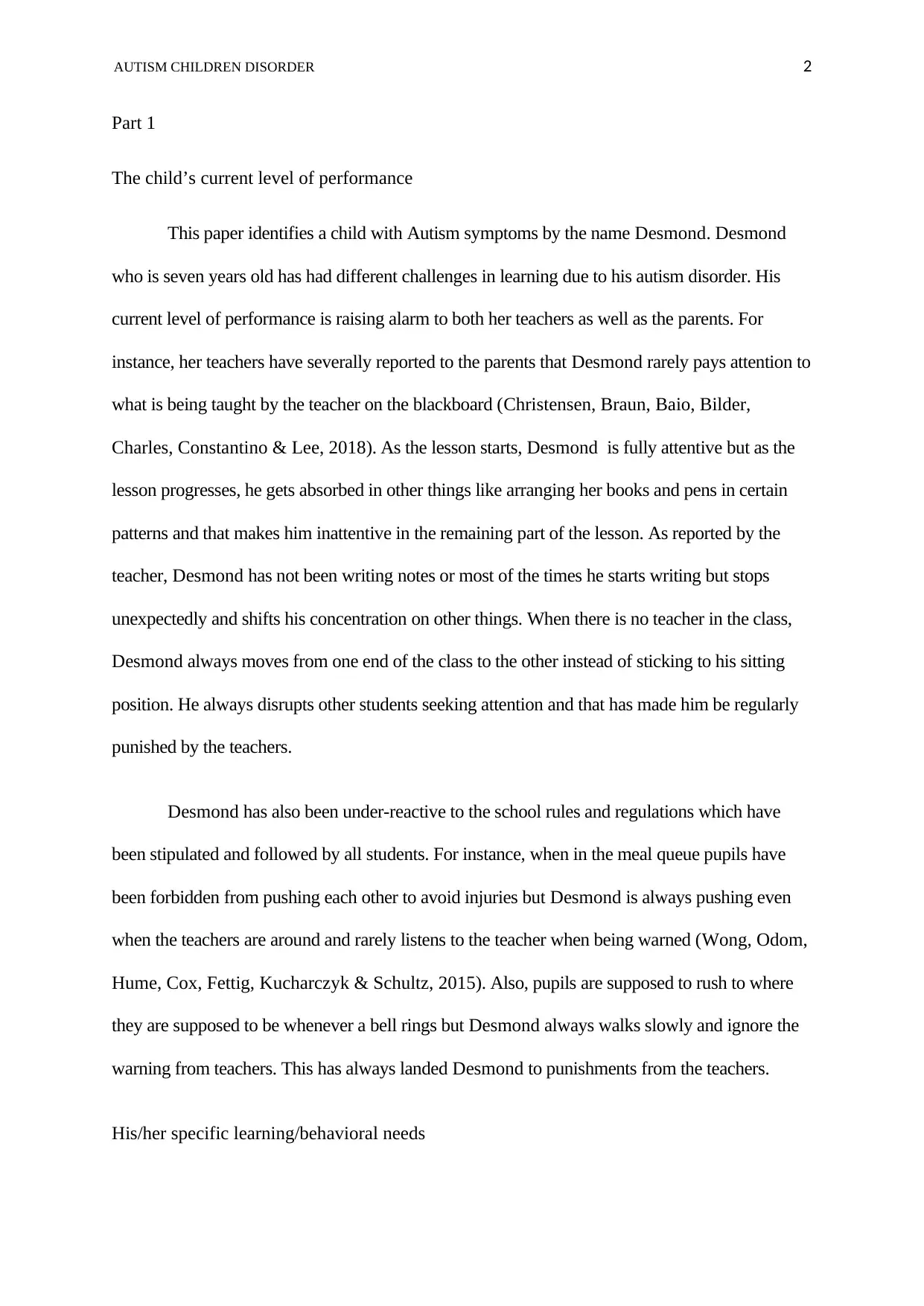
AUTISM CHILDREN DISORDER 2
Part 1
The child’s current level of performance
This paper identifies a child with Autism symptoms by the name Desmond. Desmond
who is seven years old has had different challenges in learning due to his autism disorder. His
current level of performance is raising alarm to both her teachers as well as the parents. For
instance, her teachers have severally reported to the parents that Desmond rarely pays attention to
what is being taught by the teacher on the blackboard (Christensen, Braun, Baio, Bilder,
Charles, Constantino & Lee, 2018). As the lesson starts, Desmond is fully attentive but as the
lesson progresses, he gets absorbed in other things like arranging her books and pens in certain
patterns and that makes him inattentive in the remaining part of the lesson. As reported by the
teacher, Desmond has not been writing notes or most of the times he starts writing but stops
unexpectedly and shifts his concentration on other things. When there is no teacher in the class,
Desmond always moves from one end of the class to the other instead of sticking to his sitting
position. He always disrupts other students seeking attention and that has made him be regularly
punished by the teachers.
Desmond has also been under-reactive to the school rules and regulations which have
been stipulated and followed by all students. For instance, when in the meal queue pupils have
been forbidden from pushing each other to avoid injuries but Desmond is always pushing even
when the teachers are around and rarely listens to the teacher when being warned (Wong, Odom,
Hume, Cox, Fettig, Kucharczyk & Schultz, 2015). Also, pupils are supposed to rush to where
they are supposed to be whenever a bell rings but Desmond always walks slowly and ignore the
warning from teachers. This has always landed Desmond to punishments from the teachers.
His/her specific learning/behavioral needs
Part 1
The child’s current level of performance
This paper identifies a child with Autism symptoms by the name Desmond. Desmond
who is seven years old has had different challenges in learning due to his autism disorder. His
current level of performance is raising alarm to both her teachers as well as the parents. For
instance, her teachers have severally reported to the parents that Desmond rarely pays attention to
what is being taught by the teacher on the blackboard (Christensen, Braun, Baio, Bilder,
Charles, Constantino & Lee, 2018). As the lesson starts, Desmond is fully attentive but as the
lesson progresses, he gets absorbed in other things like arranging her books and pens in certain
patterns and that makes him inattentive in the remaining part of the lesson. As reported by the
teacher, Desmond has not been writing notes or most of the times he starts writing but stops
unexpectedly and shifts his concentration on other things. When there is no teacher in the class,
Desmond always moves from one end of the class to the other instead of sticking to his sitting
position. He always disrupts other students seeking attention and that has made him be regularly
punished by the teachers.
Desmond has also been under-reactive to the school rules and regulations which have
been stipulated and followed by all students. For instance, when in the meal queue pupils have
been forbidden from pushing each other to avoid injuries but Desmond is always pushing even
when the teachers are around and rarely listens to the teacher when being warned (Wong, Odom,
Hume, Cox, Fettig, Kucharczyk & Schultz, 2015). Also, pupils are supposed to rush to where
they are supposed to be whenever a bell rings but Desmond always walks slowly and ignore the
warning from teachers. This has always landed Desmond to punishments from the teachers.
His/her specific learning/behavioral needs
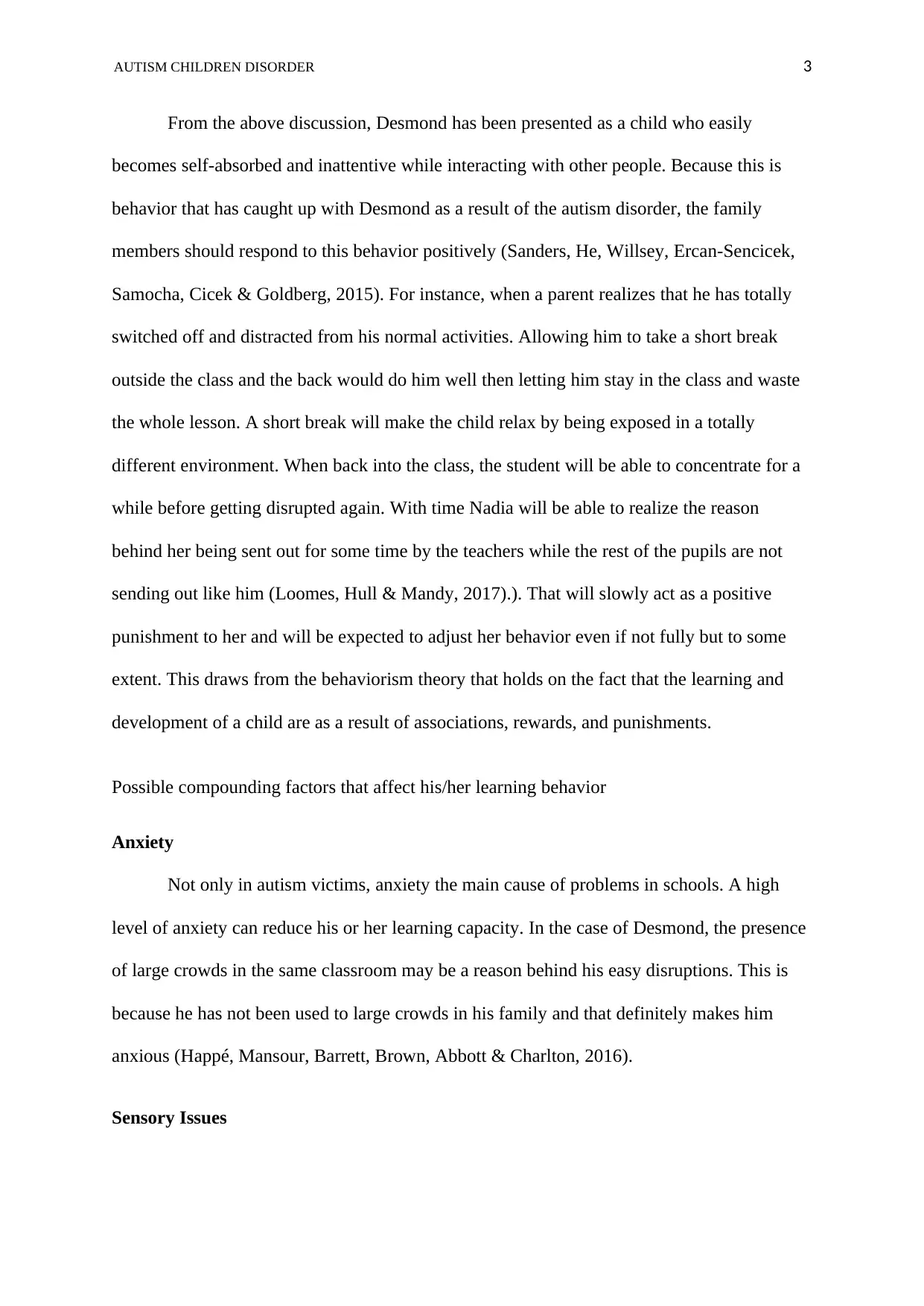
AUTISM CHILDREN DISORDER 3
From the above discussion, Desmond has been presented as a child who easily
becomes self-absorbed and inattentive while interacting with other people. Because this is
behavior that has caught up with Desmond as a result of the autism disorder, the family
members should respond to this behavior positively (Sanders, He, Willsey, Ercan-Sencicek,
Samocha, Cicek & Goldberg, 2015). For instance, when a parent realizes that he has totally
switched off and distracted from his normal activities. Allowing him to take a short break
outside the class and the back would do him well then letting him stay in the class and waste
the whole lesson. A short break will make the child relax by being exposed in a totally
different environment. When back into the class, the student will be able to concentrate for a
while before getting disrupted again. With time Nadia will be able to realize the reason
behind her being sent out for some time by the teachers while the rest of the pupils are not
sending out like him (Loomes, Hull & Mandy, 2017).). That will slowly act as a positive
punishment to her and will be expected to adjust her behavior even if not fully but to some
extent. This draws from the behaviorism theory that holds on the fact that the learning and
development of a child are as a result of associations, rewards, and punishments.
Possible compounding factors that affect his/her learning behavior
Anxiety
Not only in autism victims, anxiety the main cause of problems in schools. A high
level of anxiety can reduce his or her learning capacity. In the case of Desmond, the presence
of large crowds in the same classroom may be a reason behind his easy disruptions. This is
because he has not been used to large crowds in his family and that definitely makes him
anxious (Happé, Mansour, Barrett, Brown, Abbott & Charlton, 2016).
Sensory Issues
From the above discussion, Desmond has been presented as a child who easily
becomes self-absorbed and inattentive while interacting with other people. Because this is
behavior that has caught up with Desmond as a result of the autism disorder, the family
members should respond to this behavior positively (Sanders, He, Willsey, Ercan-Sencicek,
Samocha, Cicek & Goldberg, 2015). For instance, when a parent realizes that he has totally
switched off and distracted from his normal activities. Allowing him to take a short break
outside the class and the back would do him well then letting him stay in the class and waste
the whole lesson. A short break will make the child relax by being exposed in a totally
different environment. When back into the class, the student will be able to concentrate for a
while before getting disrupted again. With time Nadia will be able to realize the reason
behind her being sent out for some time by the teachers while the rest of the pupils are not
sending out like him (Loomes, Hull & Mandy, 2017).). That will slowly act as a positive
punishment to her and will be expected to adjust her behavior even if not fully but to some
extent. This draws from the behaviorism theory that holds on the fact that the learning and
development of a child are as a result of associations, rewards, and punishments.
Possible compounding factors that affect his/her learning behavior
Anxiety
Not only in autism victims, anxiety the main cause of problems in schools. A high
level of anxiety can reduce his or her learning capacity. In the case of Desmond, the presence
of large crowds in the same classroom may be a reason behind his easy disruptions. This is
because he has not been used to large crowds in his family and that definitely makes him
anxious (Happé, Mansour, Barrett, Brown, Abbott & Charlton, 2016).
Sensory Issues
⊘ This is a preview!⊘
Do you want full access?
Subscribe today to unlock all pages.

Trusted by 1+ million students worldwide
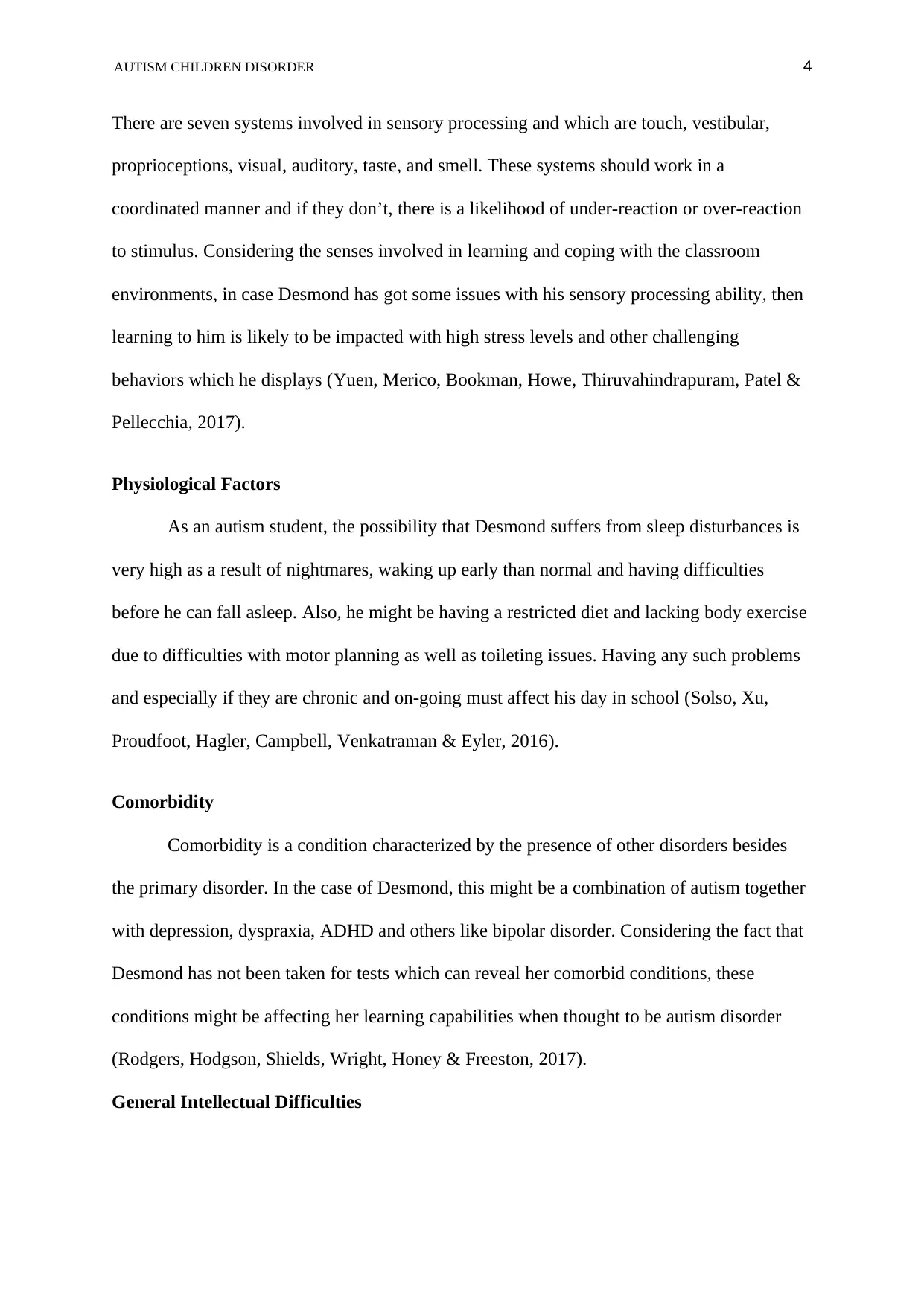
AUTISM CHILDREN DISORDER 4
There are seven systems involved in sensory processing and which are touch, vestibular,
proprioceptions, visual, auditory, taste, and smell. These systems should work in a
coordinated manner and if they don’t, there is a likelihood of under-reaction or over-reaction
to stimulus. Considering the senses involved in learning and coping with the classroom
environments, in case Desmond has got some issues with his sensory processing ability, then
learning to him is likely to be impacted with high stress levels and other challenging
behaviors which he displays (Yuen, Merico, Bookman, Howe, Thiruvahindrapuram, Patel &
Pellecchia, 2017).
Physiological Factors
As an autism student, the possibility that Desmond suffers from sleep disturbances is
very high as a result of nightmares, waking up early than normal and having difficulties
before he can fall asleep. Also, he might be having a restricted diet and lacking body exercise
due to difficulties with motor planning as well as toileting issues. Having any such problems
and especially if they are chronic and on-going must affect his day in school (Solso, Xu,
Proudfoot, Hagler, Campbell, Venkatraman & Eyler, 2016).
Comorbidity
Comorbidity is a condition characterized by the presence of other disorders besides
the primary disorder. In the case of Desmond, this might be a combination of autism together
with depression, dyspraxia, ADHD and others like bipolar disorder. Considering the fact that
Desmond has not been taken for tests which can reveal her comorbid conditions, these
conditions might be affecting her learning capabilities when thought to be autism disorder
(Rodgers, Hodgson, Shields, Wright, Honey & Freeston, 2017).
General Intellectual Difficulties
There are seven systems involved in sensory processing and which are touch, vestibular,
proprioceptions, visual, auditory, taste, and smell. These systems should work in a
coordinated manner and if they don’t, there is a likelihood of under-reaction or over-reaction
to stimulus. Considering the senses involved in learning and coping with the classroom
environments, in case Desmond has got some issues with his sensory processing ability, then
learning to him is likely to be impacted with high stress levels and other challenging
behaviors which he displays (Yuen, Merico, Bookman, Howe, Thiruvahindrapuram, Patel &
Pellecchia, 2017).
Physiological Factors
As an autism student, the possibility that Desmond suffers from sleep disturbances is
very high as a result of nightmares, waking up early than normal and having difficulties
before he can fall asleep. Also, he might be having a restricted diet and lacking body exercise
due to difficulties with motor planning as well as toileting issues. Having any such problems
and especially if they are chronic and on-going must affect his day in school (Solso, Xu,
Proudfoot, Hagler, Campbell, Venkatraman & Eyler, 2016).
Comorbidity
Comorbidity is a condition characterized by the presence of other disorders besides
the primary disorder. In the case of Desmond, this might be a combination of autism together
with depression, dyspraxia, ADHD and others like bipolar disorder. Considering the fact that
Desmond has not been taken for tests which can reveal her comorbid conditions, these
conditions might be affecting her learning capabilities when thought to be autism disorder
(Rodgers, Hodgson, Shields, Wright, Honey & Freeston, 2017).
General Intellectual Difficulties
Paraphrase This Document
Need a fresh take? Get an instant paraphrase of this document with our AI Paraphraser
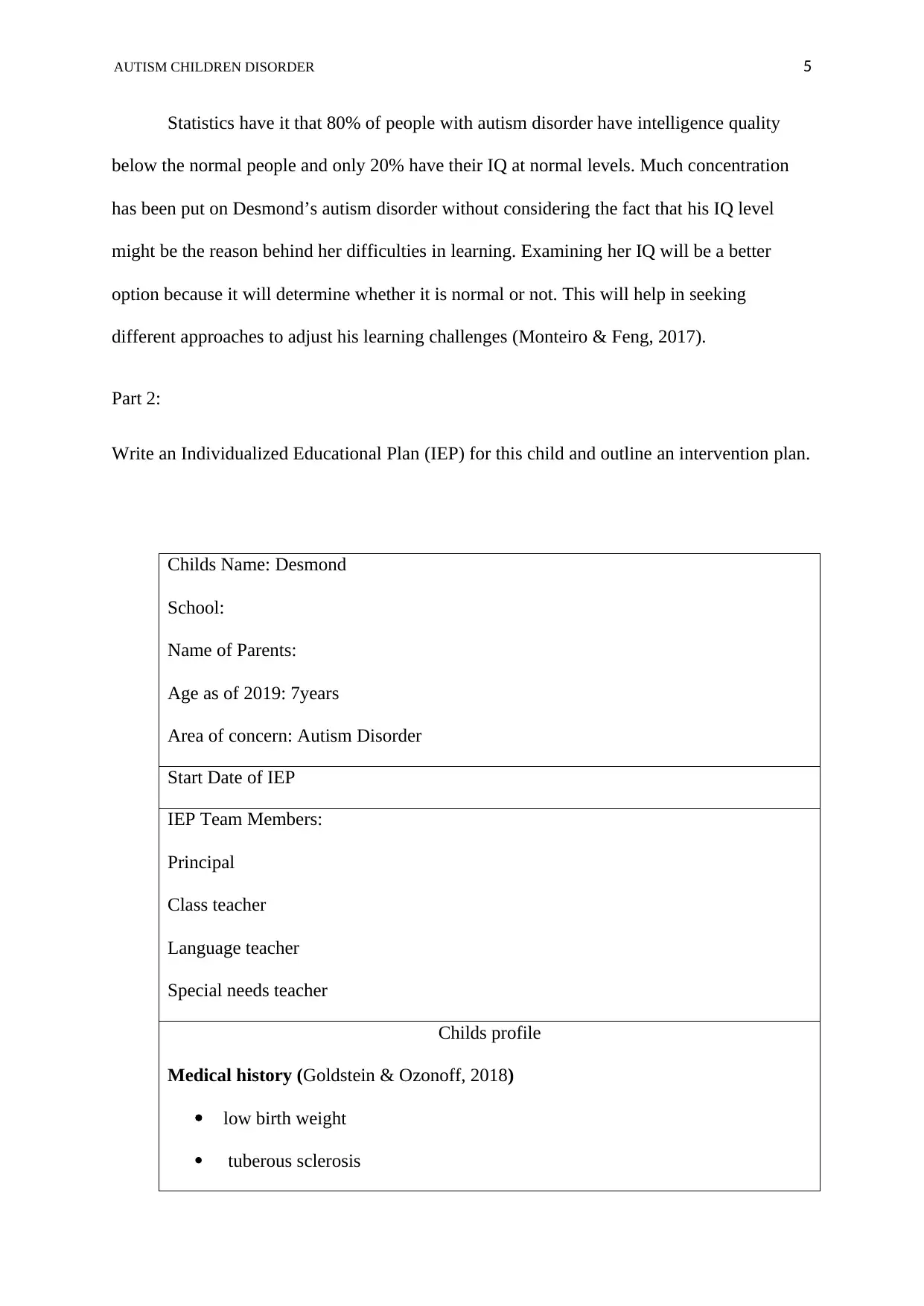
AUTISM CHILDREN DISORDER 5
Statistics have it that 80% of people with autism disorder have intelligence quality
below the normal people and only 20% have their IQ at normal levels. Much concentration
has been put on Desmond’s autism disorder without considering the fact that his IQ level
might be the reason behind her difficulties in learning. Examining her IQ will be a better
option because it will determine whether it is normal or not. This will help in seeking
different approaches to adjust his learning challenges (Monteiro & Feng, 2017).
Part 2:
Write an Individualized Educational Plan (IEP) for this child and outline an intervention plan.
Childs Name: Desmond
School:
Name of Parents:
Age as of 2019: 7years
Area of concern: Autism Disorder
Start Date of IEP
IEP Team Members:
Principal
Class teacher
Language teacher
Special needs teacher
Childs profile
Medical history (Goldstein & Ozonoff, 2018)
low birth weight
tuberous sclerosis
Statistics have it that 80% of people with autism disorder have intelligence quality
below the normal people and only 20% have their IQ at normal levels. Much concentration
has been put on Desmond’s autism disorder without considering the fact that his IQ level
might be the reason behind her difficulties in learning. Examining her IQ will be a better
option because it will determine whether it is normal or not. This will help in seeking
different approaches to adjust his learning challenges (Monteiro & Feng, 2017).
Part 2:
Write an Individualized Educational Plan (IEP) for this child and outline an intervention plan.
Childs Name: Desmond
School:
Name of Parents:
Age as of 2019: 7years
Area of concern: Autism Disorder
Start Date of IEP
IEP Team Members:
Principal
Class teacher
Language teacher
Special needs teacher
Childs profile
Medical history (Goldstein & Ozonoff, 2018)
low birth weight
tuberous sclerosis
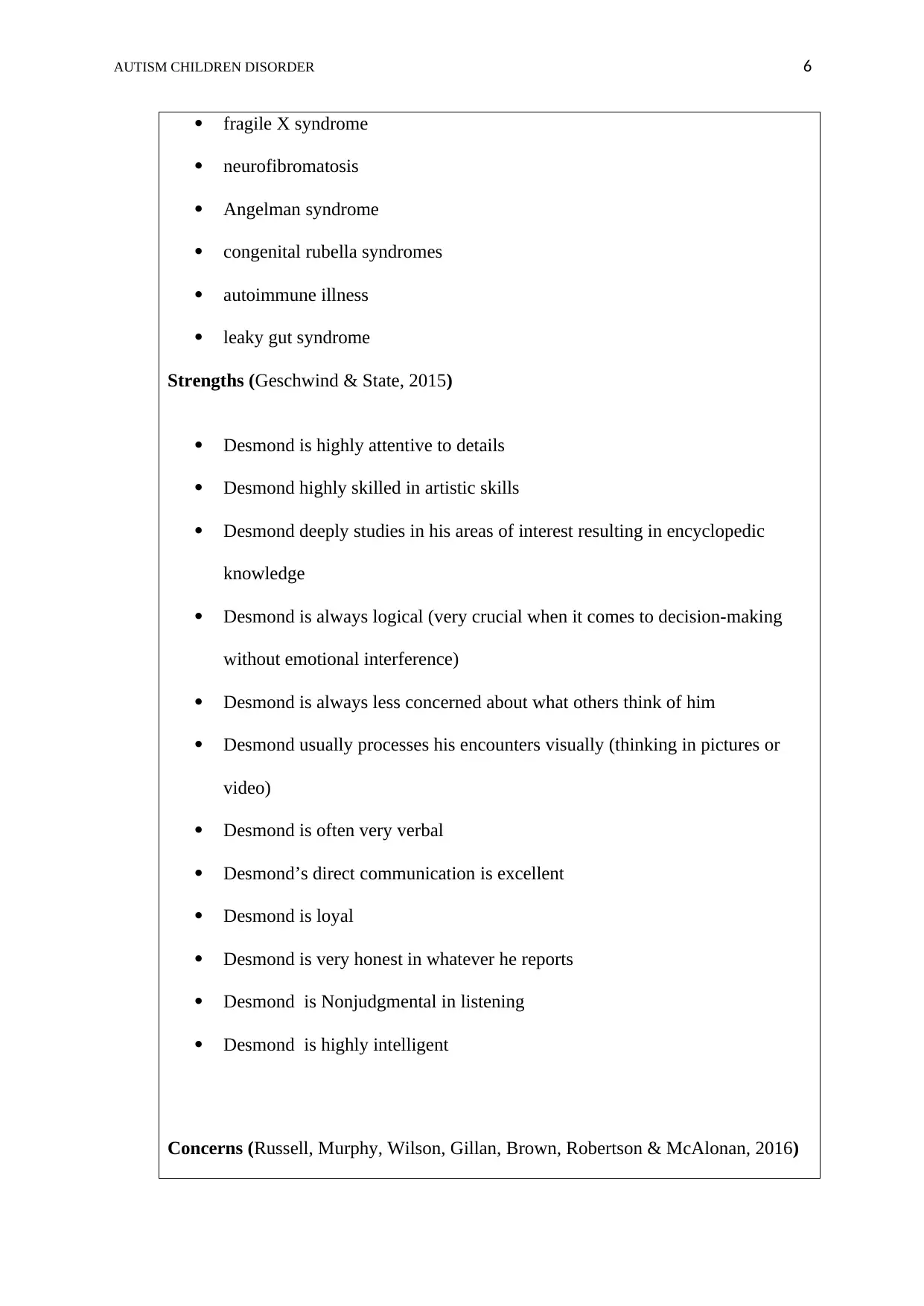
AUTISM CHILDREN DISORDER 6
fragile X syndrome
neurofibromatosis
Angelman syndrome
congenital rubella syndromes
autoimmune illness
leaky gut syndrome
Strengths (Geschwind & State, 2015)
Desmond is highly attentive to details
Desmond highly skilled in artistic skills
Desmond deeply studies in his areas of interest resulting in encyclopedic
knowledge
Desmond is always logical (very crucial when it comes to decision-making
without emotional interference)
Desmond is always less concerned about what others think of him
Desmond usually processes his encounters visually (thinking in pictures or
video)
Desmond is often very verbal
Desmond’s direct communication is excellent
Desmond is loyal
Desmond is very honest in whatever he reports
Desmond is Nonjudgmental in listening
Desmond is highly intelligent
Concerns (Russell, Murphy, Wilson, Gillan, Brown, Robertson & McAlonan, 2016)
fragile X syndrome
neurofibromatosis
Angelman syndrome
congenital rubella syndromes
autoimmune illness
leaky gut syndrome
Strengths (Geschwind & State, 2015)
Desmond is highly attentive to details
Desmond highly skilled in artistic skills
Desmond deeply studies in his areas of interest resulting in encyclopedic
knowledge
Desmond is always logical (very crucial when it comes to decision-making
without emotional interference)
Desmond is always less concerned about what others think of him
Desmond usually processes his encounters visually (thinking in pictures or
video)
Desmond is often very verbal
Desmond’s direct communication is excellent
Desmond is loyal
Desmond is very honest in whatever he reports
Desmond is Nonjudgmental in listening
Desmond is highly intelligent
Concerns (Russell, Murphy, Wilson, Gillan, Brown, Robertson & McAlonan, 2016)
⊘ This is a preview!⊘
Do you want full access?
Subscribe today to unlock all pages.

Trusted by 1+ million students worldwide
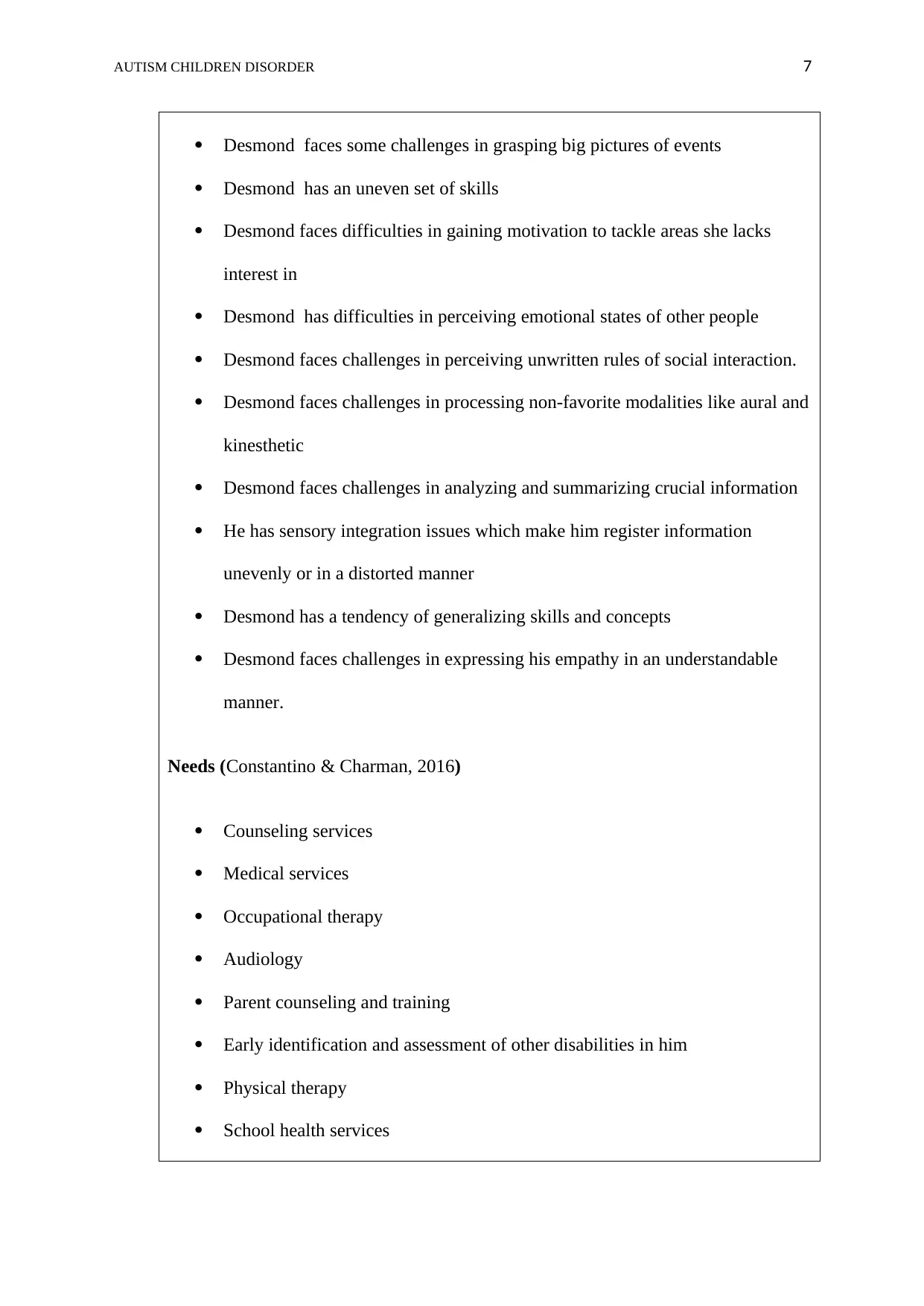
AUTISM CHILDREN DISORDER 7
Desmond faces some challenges in grasping big pictures of events
Desmond has an uneven set of skills
Desmond faces difficulties in gaining motivation to tackle areas she lacks
interest in
Desmond has difficulties in perceiving emotional states of other people
Desmond faces challenges in perceiving unwritten rules of social interaction.
Desmond faces challenges in processing non-favorite modalities like aural and
kinesthetic
Desmond faces challenges in analyzing and summarizing crucial information
He has sensory integration issues which make him register information
unevenly or in a distorted manner
Desmond has a tendency of generalizing skills and concepts
Desmond faces challenges in expressing his empathy in an understandable
manner.
Needs (Constantino & Charman, 2016)
Counseling services
Medical services
Occupational therapy
Audiology
Parent counseling and training
Early identification and assessment of other disabilities in him
Physical therapy
School health services
Desmond faces some challenges in grasping big pictures of events
Desmond has an uneven set of skills
Desmond faces difficulties in gaining motivation to tackle areas she lacks
interest in
Desmond has difficulties in perceiving emotional states of other people
Desmond faces challenges in perceiving unwritten rules of social interaction.
Desmond faces challenges in processing non-favorite modalities like aural and
kinesthetic
Desmond faces challenges in analyzing and summarizing crucial information
He has sensory integration issues which make him register information
unevenly or in a distorted manner
Desmond has a tendency of generalizing skills and concepts
Desmond faces challenges in expressing his empathy in an understandable
manner.
Needs (Constantino & Charman, 2016)
Counseling services
Medical services
Occupational therapy
Audiology
Parent counseling and training
Early identification and assessment of other disabilities in him
Physical therapy
School health services
Paraphrase This Document
Need a fresh take? Get an instant paraphrase of this document with our AI Paraphraser
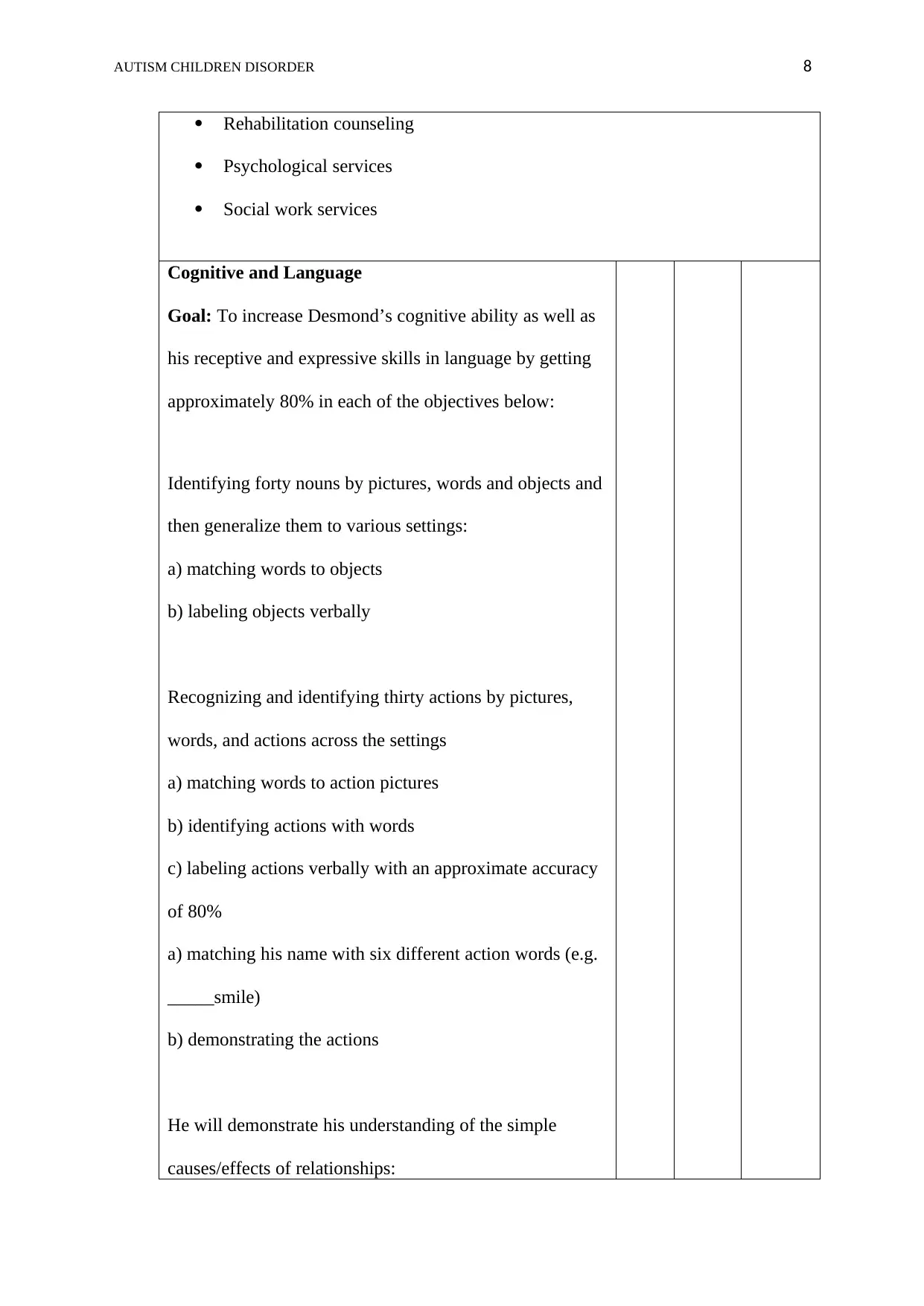
AUTISM CHILDREN DISORDER 8
Rehabilitation counseling
Psychological services
Social work services
Cognitive and Language
Goal: To increase Desmond’s cognitive ability as well as
his receptive and expressive skills in language by getting
approximately 80% in each of the objectives below:
Identifying forty nouns by pictures, words and objects and
then generalize them to various settings:
a) matching words to objects
b) labeling objects verbally
Recognizing and identifying thirty actions by pictures,
words, and actions across the settings
a) matching words to action pictures
b) identifying actions with words
c) labeling actions verbally with an approximate accuracy
of 80%
a) matching his name with six different action words (e.g.
_____smile)
b) demonstrating the actions
He will demonstrate his understanding of the simple
causes/effects of relationships:
Rehabilitation counseling
Psychological services
Social work services
Cognitive and Language
Goal: To increase Desmond’s cognitive ability as well as
his receptive and expressive skills in language by getting
approximately 80% in each of the objectives below:
Identifying forty nouns by pictures, words and objects and
then generalize them to various settings:
a) matching words to objects
b) labeling objects verbally
Recognizing and identifying thirty actions by pictures,
words, and actions across the settings
a) matching words to action pictures
b) identifying actions with words
c) labeling actions verbally with an approximate accuracy
of 80%
a) matching his name with six different action words (e.g.
_____smile)
b) demonstrating the actions
He will demonstrate his understanding of the simple
causes/effects of relationships:
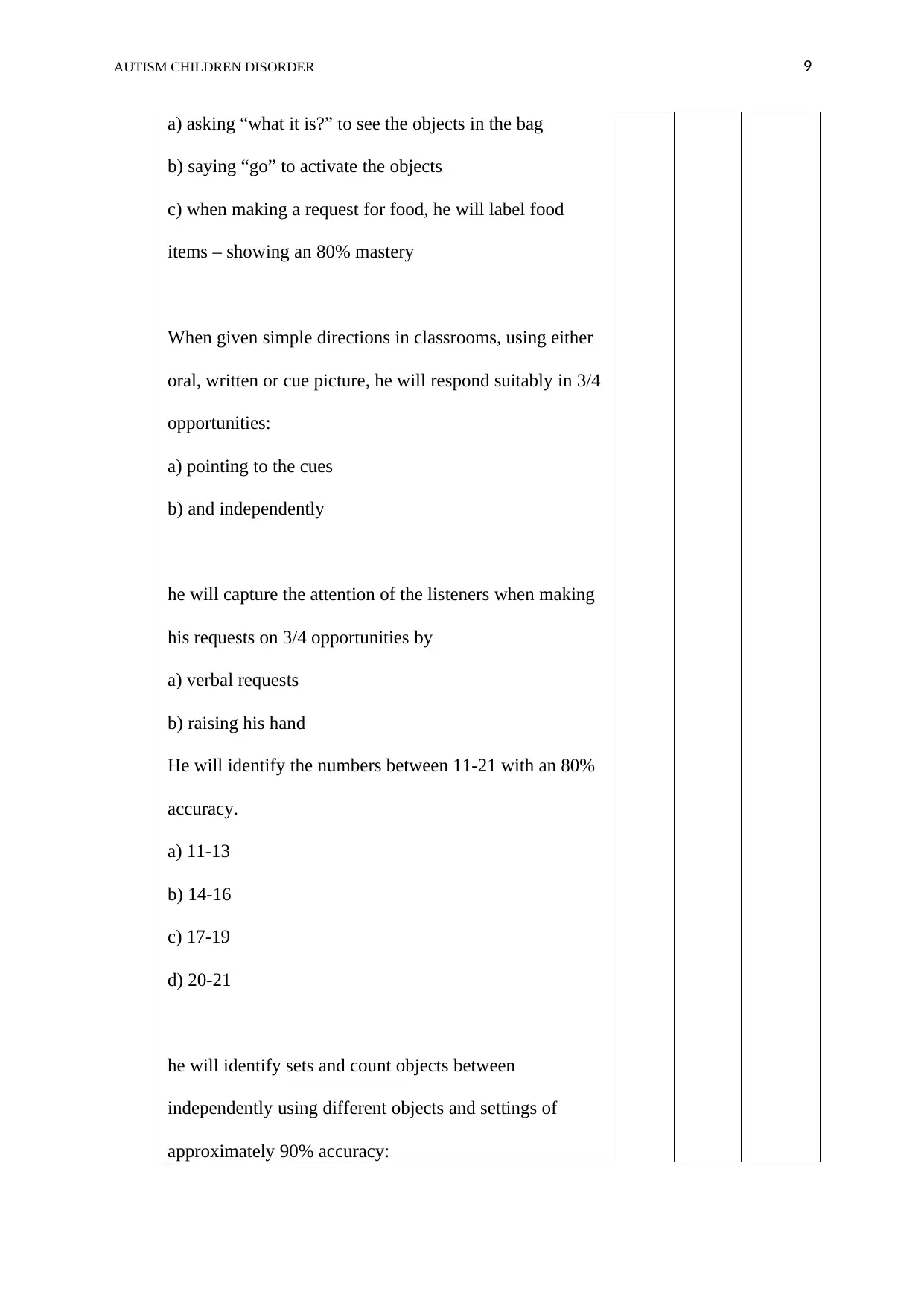
AUTISM CHILDREN DISORDER 9
a) asking “what it is?” to see the objects in the bag
b) saying “go” to activate the objects
c) when making a request for food, he will label food
items – showing an 80% mastery
When given simple directions in classrooms, using either
oral, written or cue picture, he will respond suitably in 3/4
opportunities:
a) pointing to the cues
b) and independently
he will capture the attention of the listeners when making
his requests on 3/4 opportunities by
a) verbal requests
b) raising his hand
He will identify the numbers between 11-21 with an 80%
accuracy.
a) 11-13
b) 14-16
c) 17-19
d) 20-21
he will identify sets and count objects between
independently using different objects and settings of
approximately 90% accuracy:
a) asking “what it is?” to see the objects in the bag
b) saying “go” to activate the objects
c) when making a request for food, he will label food
items – showing an 80% mastery
When given simple directions in classrooms, using either
oral, written or cue picture, he will respond suitably in 3/4
opportunities:
a) pointing to the cues
b) and independently
he will capture the attention of the listeners when making
his requests on 3/4 opportunities by
a) verbal requests
b) raising his hand
He will identify the numbers between 11-21 with an 80%
accuracy.
a) 11-13
b) 14-16
c) 17-19
d) 20-21
he will identify sets and count objects between
independently using different objects and settings of
approximately 90% accuracy:
⊘ This is a preview!⊘
Do you want full access?
Subscribe today to unlock all pages.

Trusted by 1+ million students worldwide
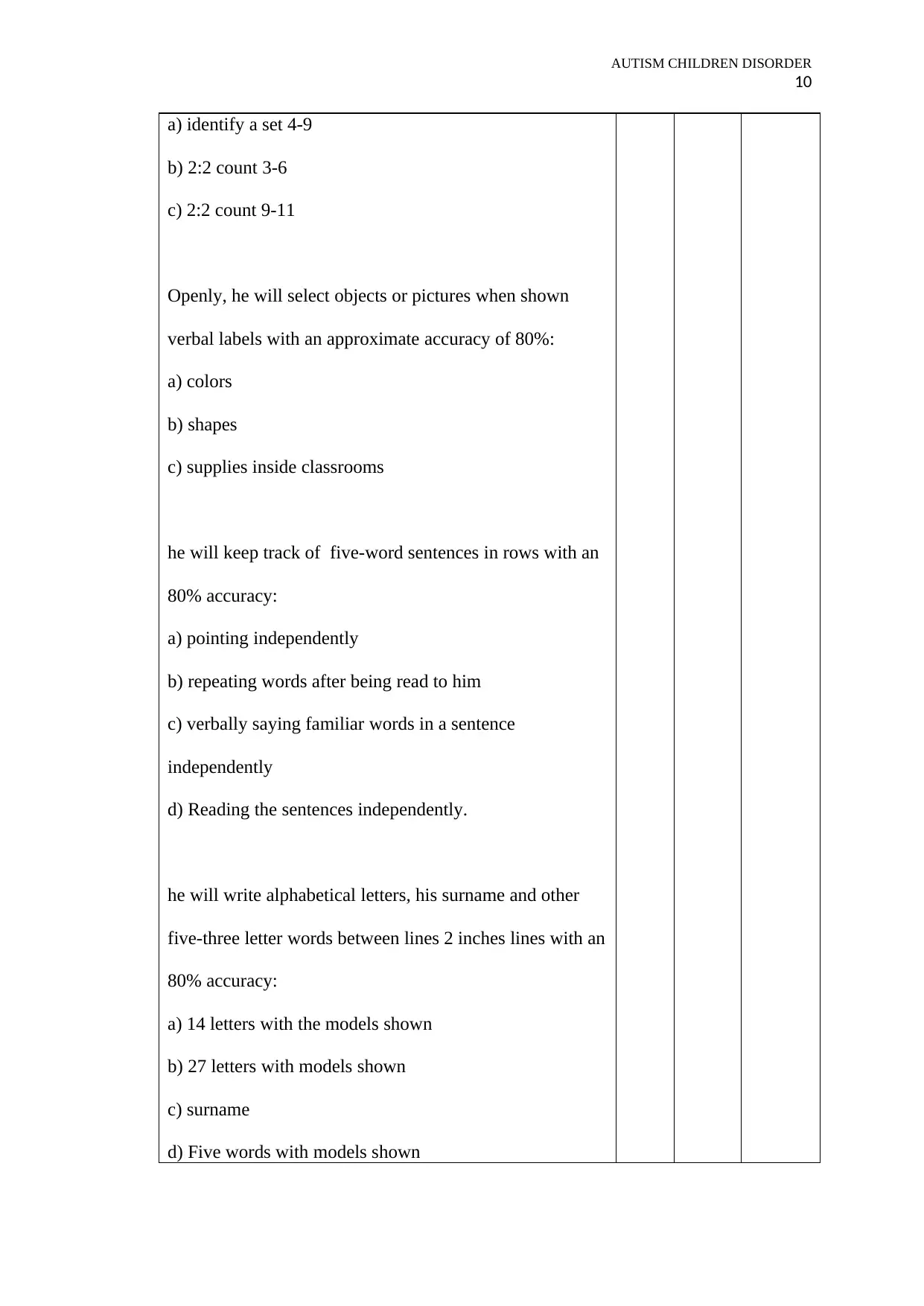
AUTISM CHILDREN DISORDER
10
a) identify a set 4-9
b) 2:2 count 3-6
c) 2:2 count 9-11
Openly, he will select objects or pictures when shown
verbal labels with an approximate accuracy of 80%:
a) colors
b) shapes
c) supplies inside classrooms
he will keep track of five-word sentences in rows with an
80% accuracy:
a) pointing independently
b) repeating words after being read to him
c) verbally saying familiar words in a sentence
independently
d) Reading the sentences independently.
he will write alphabetical letters, his surname and other
five-three letter words between lines 2 inches lines with an
80% accuracy:
a) 14 letters with the models shown
b) 27 letters with models shown
c) surname
d) Five words with models shown
10
a) identify a set 4-9
b) 2:2 count 3-6
c) 2:2 count 9-11
Openly, he will select objects or pictures when shown
verbal labels with an approximate accuracy of 80%:
a) colors
b) shapes
c) supplies inside classrooms
he will keep track of five-word sentences in rows with an
80% accuracy:
a) pointing independently
b) repeating words after being read to him
c) verbally saying familiar words in a sentence
independently
d) Reading the sentences independently.
he will write alphabetical letters, his surname and other
five-three letter words between lines 2 inches lines with an
80% accuracy:
a) 14 letters with the models shown
b) 27 letters with models shown
c) surname
d) Five words with models shown
Paraphrase This Document
Need a fresh take? Get an instant paraphrase of this document with our AI Paraphraser
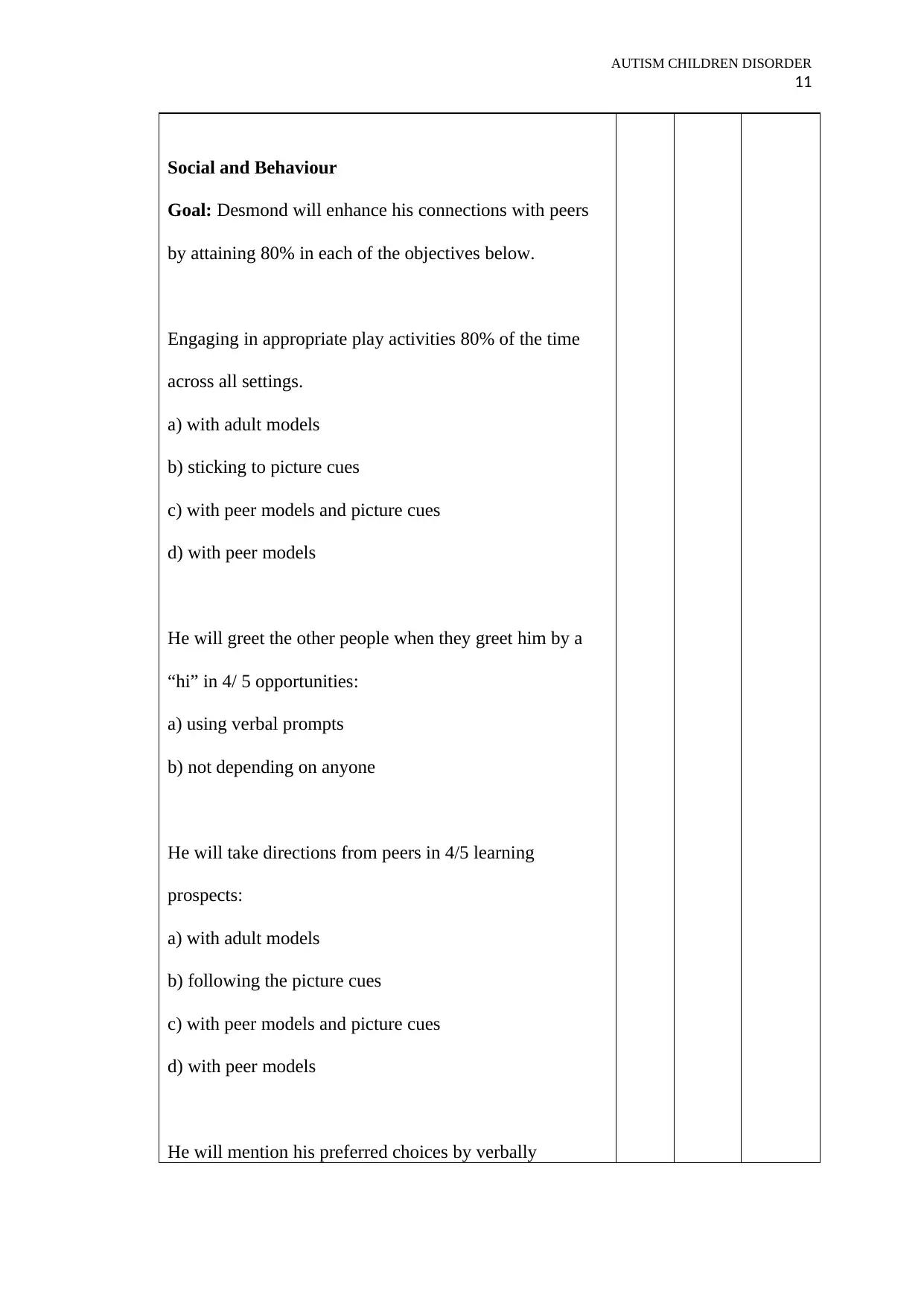
AUTISM CHILDREN DISORDER
11
Social and Behaviour
Goal: Desmond will enhance his connections with peers
by attaining 80% in each of the objectives below.
Engaging in appropriate play activities 80% of the time
across all settings.
a) with adult models
b) sticking to picture cues
c) with peer models and picture cues
d) with peer models
He will greet the other people when they greet him by a
“hi” in 4/ 5 opportunities:
a) using verbal prompts
b) not depending on anyone
He will take directions from peers in 4/5 learning
prospects:
a) with adult models
b) following the picture cues
c) with peer models and picture cues
d) with peer models
He will mention his preferred choices by verbally
11
Social and Behaviour
Goal: Desmond will enhance his connections with peers
by attaining 80% in each of the objectives below.
Engaging in appropriate play activities 80% of the time
across all settings.
a) with adult models
b) sticking to picture cues
c) with peer models and picture cues
d) with peer models
He will greet the other people when they greet him by a
“hi” in 4/ 5 opportunities:
a) using verbal prompts
b) not depending on anyone
He will take directions from peers in 4/5 learning
prospects:
a) with adult models
b) following the picture cues
c) with peer models and picture cues
d) with peer models
He will mention his preferred choices by verbally
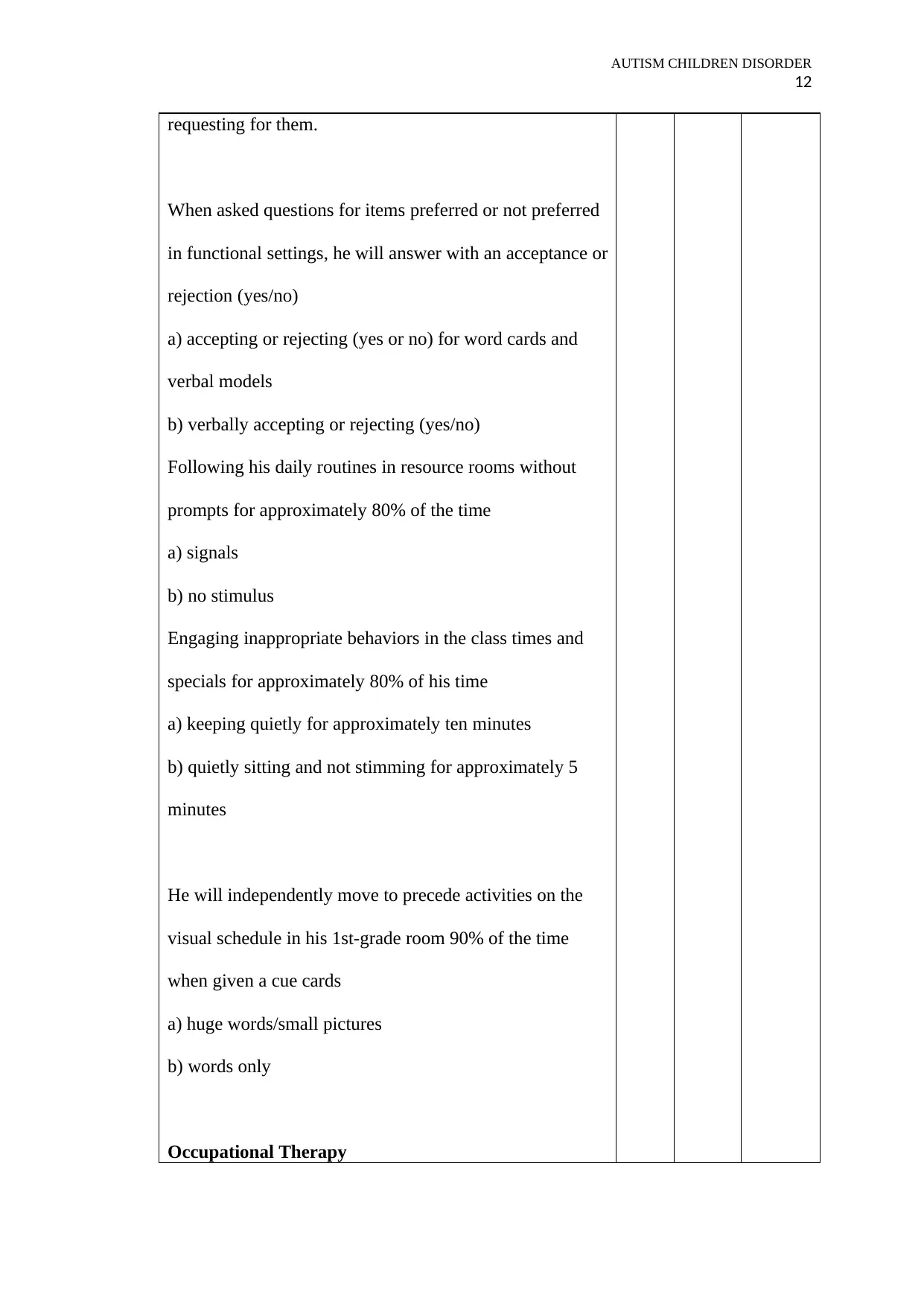
AUTISM CHILDREN DISORDER
12
requesting for them.
When asked questions for items preferred or not preferred
in functional settings, he will answer with an acceptance or
rejection (yes/no)
a) accepting or rejecting (yes or no) for word cards and
verbal models
b) verbally accepting or rejecting (yes/no)
Following his daily routines in resource rooms without
prompts for approximately 80% of the time
a) signals
b) no stimulus
Engaging inappropriate behaviors in the class times and
specials for approximately 80% of his time
a) keeping quietly for approximately ten minutes
b) quietly sitting and not stimming for approximately 5
minutes
He will independently move to precede activities on the
visual schedule in his 1st-grade room 90% of the time
when given a cue cards
a) huge words/small pictures
b) words only
Occupational Therapy
12
requesting for them.
When asked questions for items preferred or not preferred
in functional settings, he will answer with an acceptance or
rejection (yes/no)
a) accepting or rejecting (yes or no) for word cards and
verbal models
b) verbally accepting or rejecting (yes/no)
Following his daily routines in resource rooms without
prompts for approximately 80% of the time
a) signals
b) no stimulus
Engaging inappropriate behaviors in the class times and
specials for approximately 80% of his time
a) keeping quietly for approximately ten minutes
b) quietly sitting and not stimming for approximately 5
minutes
He will independently move to precede activities on the
visual schedule in his 1st-grade room 90% of the time
when given a cue cards
a) huge words/small pictures
b) words only
Occupational Therapy
⊘ This is a preview!⊘
Do you want full access?
Subscribe today to unlock all pages.

Trusted by 1+ million students worldwide
1 out of 15
Related Documents
Your All-in-One AI-Powered Toolkit for Academic Success.
+13062052269
info@desklib.com
Available 24*7 on WhatsApp / Email
![[object Object]](/_next/static/media/star-bottom.7253800d.svg)
Unlock your academic potential
Copyright © 2020–2025 A2Z Services. All Rights Reserved. Developed and managed by ZUCOL.





